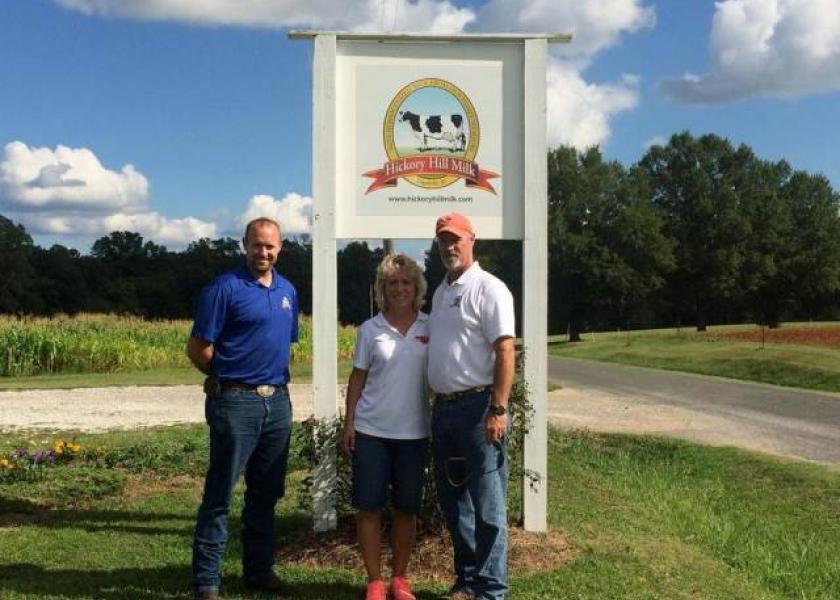Dairy Farm Produces Milk for Clemson Blue Cheese

Hickory Hill Milk dairy farm in Edgefield County, S.C. produces non-homogenized whole milk, chocolate milk and buttermilk.
By: Susan Ardis, The State of Columbia
The Dorn family has been on the same patch of ground in Edgefield County, S.C. since 1764.
And, that land has always been used for farming.
About 50 years ago, Watson Dorn's grandfather Marvin decided to start the dairy business, clearing the land and raising Holstein cows. The farm passed from Marvin to son Jim, who served on the S.C. Dairy Commission and the National dairy Board.
Today, it is Watson Dorn, a Clemson University graduate with a degree in agricultural education, who is running the Hickory Hill operation.
"Our main concern is taking care of the cows," Watson Dorn said. "We have to keep them happy and healthy so that they are productive."
His operation includes not only raising Holsteins but providing milk and overseeing management and production of a product near and dear to the Clemson graduate's heart - Clemson Blue cheese.
It isn't easy being an independent dairy farmer in South Carolina.
According to a 2002 Statistical Bulletin published by the USDA called "The Changing Landscape of U.S. Milk Production, from 1975 to 2000," milk production in South Carolina dropped to 369 million pounds from 512 million pounds.
And the number of (cow) dairy farms is down, too, to 75 in 2013 from 365 dairies in 1982, according to the USDA census and S.C. Dairy Association Inc.
Economics plays a large part in shaping the landscape of farming, as it does in most areas.
As Dorn put it, either dairies "got bigger, found a way to go straight to consumer or got out" of the business.
That's exactly what Dorn did seven years ago, when he decided it was time for Hickory Hill to begin processing its own milk.
Going straight to consumers and local distributors would help maintain a constant price for the milk rather than being subject to the fluctuating prices of a co-op (for instance, local milk prices in South Carolina are determined by the price of cheese sold on the Chicago Mercantile Exchange). Being local is a definite advantage, especially with the growing sustainability trend of restaurants and consumers trying to source as much as they can from local producers. Having a reliable and locally produced high quality product also creates loyalty and a foundation on which a business can grow.
It's the high quality of the product that Dorn and Hickory Hill Milk strive to maintain.
Dorn's cows are mainly grass fed with a diet that is monitored and tweaked by a professional nutritionist. Every two weeks, the corn silage feed that supplements the grass is analyzed for quality, making sure that the cows are getting enough protein, fiber, carbohydrates and such in their diet. If the tests come back and the diet needs to be adjusted, then wheat straw, ground corn and/or minerals will be added in a precise recipe that is mixed at the farm and fed to the herd.
Dorn keeps detailed records of his herd, some cattle lines going back ten generations.
The equipment in his milking room reads a chip on a tag placed in the left ear of each cow and tracks the last time the cow was milked, who milked her and the amount of milk produced (the average Hickory Hill Milk cow produces seven gallons of milk per day). This information is combined with other records so that Dorn can pull up the profile of a single cow and see every detail of the animal's life: when it was bred, when it might calf, how much milk has produced over its lifetime...
"It all starts with the cow," he said.
It's also all about the milk.
When Dorn decided that it was time for Hickory Hill Milk to begin processing and bottling on-site, he found "no scientific reason to homogenize the milk." The vat pasteurization process that his milk goes through is a low heat, longer time procedure that keeps the fat molecules in the milk intact. That means if you let a bottle of Hickory Hill Milk stand long enough, the fat forms a natural cream line. Shaking the carton rejoins the milk and the cream into whole milk.
"Whole milk, skim milk, all milk is nutritious and everyone needs to be drinking more of it," he said. "Just be aware of your choices."
You can find Hickory Hill Milk locally in EarthFare and Whole Foods in Columbia, at select Bi-Lo locations in Columbia and Lexington or you can buy directly from the farm in Edgefield. The chocolate milk is rich and chocolate-y without any alkaline aftertaste.
CLEMSON BLUE
Since 1941, Clemson University has been making a version of bleu (French spelling) cheese, after Professor Paul Miller discovered that the Stumphouse Tunnel near campus was the perfect environment for the natural aging of the cheese.
Clemson Blue became a legacy product, and the university managed the cheese operation until 1997, when it was turned over to Aramark, a food service company. When it looked like the future of the Blue was uncertain, former Clemson trustee Billy Amick suggested that Dorn, a Clemson graduate, take over the management, distribution and production of Clemson Blue cheese.
Today, Clemson cheese master Anthony Pounders makes the cheese and Dorn provides the milk and oversees production and distribution. Clemson Blue cheese and blue cheese dressing is available online, on campus within the Hendrix Student Center and at Hickory Hill Milk dairy farm.







